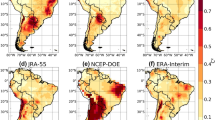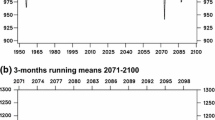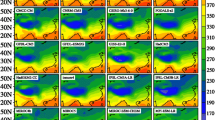Abstract.
Global simulations with the Bureau of Meteorology Research Centre climate model coupled to the CHAmeleon Surface Model (CHASM) are used to explore the sensitivity of simulated changes in evaporation, precipitation, air temperature and soil moisture resulting from a doubling of carbon dioxide in the atmosphere. Five simulations, using prescribed sea surface temperatures, are conducted which are identical except in the level of complexity used to represent the surface energy balance. The simulation of air temperature, precipitation, evaporation and soil moisture at 1 × CO2 and at 2 × CO2 are generally sensitive at statistically significant levels to the complexity of the surface energy balance representation (i.e. the level of complexity used to represent these processes affects the simulated climate). However, changes in mean quantities, resulting from a doubling of atmospheric CO2, are generally insensitive to the surface energy balance complexity. Conversely, changes in the spatial and temporal variance of evaporation and soil moisture are sensitive to the surface energy balance complexity. The addition of explicit canopy interception to the simplest model examined here enables that model to capture the change in the variance of evaporation simulated by the more complex models. In order to simulate changes in the variability of soil moisture, an explicit parameterization of bare soil evaporation is required. Overall, our results increase confidence that the simulation by climate models of the mean impact of increasing CO2 on climate are reliable. Changes in the variability resulting from increased CO2 on air temperature, precipitation or evaporation are also likely to be reliable since climate models typically use sufficiently complex land surface schemes. However, if the impact of increased CO2 on soil moisture is required, then a more complex surface energy balance representation may be needed in order to capture changes in variability. Overall, our results imply that the level of complexity used by most climate models to represent the surface energy balance is appropriate and does not contribute significant uncertainty in the simulation of changes resulting from increasing CO2. Our results only relate to surface energy balance complexity, and major uncertainties remain in how to model the surface hydrology and changes in the physiology, structural characteristics and distribution of vegetation. Future developments of land surface models should therefore focus on improving the representation of these processes.
Similar content being viewed by others
Author information
Authors and Affiliations
Additional information
Electronic Publication
Rights and permissions
About this article
Cite this article
Pitman, .A., McAvaney, .B. The role of surface energy balance complexity in land surface models' sensitivity to increasing carbon dioxide. Climate Dynamics 19, 609–618 (2002). https://doi.org/10.1007/s00382-002-0250-z
Received:
Accepted:
Issue Date:
DOI: https://doi.org/10.1007/s00382-002-0250-z




